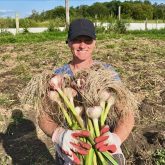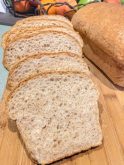“There’s been quite a bit of interest in ancient grains recently due to allergies to wheat and celiac disease. There’s so many people who have allergies or
sensitivities to gluten.”
– ANNETTE ALLEN, MAFRI
When old-timers talk about old wheat varieties, they might mention Red Fife or Thatcher.
But wheat breeding goes way back to the ancestors of those venerable grains – way, way back.
Einkorn, for example, may be the “missing link” between wild grain-bearing grasses and domesticated varieties, and evidence has been found in Mesopotamia indicating that it was grown for food as early as 9,000 years ago.
Read Also

CUSMA access key among other trade noise: Seeds Canada panel
Seeds Canada conference panelists say Canada needs to stay focused and wait as U.S. trade and tariff chaos develops, and a Canada-U.S.-Mexico Agreement review looms
Spelt, another ancient staple food, was grown in the area around the Black Sea as far back as 7,000 years ago, and is thought to have risen as a hybrid of its predecessor emmer wheat and a wild goat grass.
It was a principle grain sustaining the Germanic tribes that battled Julius Caesar when the Roman Empire was at its peak, and much of Europe throughout the Middle Ages.
Difficult to thresh due to their heavy seed coats, the old grains fell out of favour when newer, higher-yielding varieties emerged. However, they have lately been making a comeback on the shelves of specialty bread and health food stores.
SHOW AND TELL
Visitors to four agriculture research stations this summer will get a chance to see how the great-granddaddies of wheat measure up to the latest varieties, according to Annette Allen, a MAFRI business development specialist based in Roblin.
Diversification centres in Melita, Carberry, Arborg and Roblin this spring have sown einkorn, spelt, and others, including Kamut, an Egyptian wheat variety, and the Ethiopian staple “teff,” as part of an agronomic study to gauge their performance under local conditions.
As a value chain specialist, Allen is keen to convince farmers of the merits of identifying niche products currently in demand, and then
working backwards – to build a supply for those markets. This strategy could help small operators improve profitability in a realm outside of the lowest-cost-is-king commodity trap, she added.
“There’s been quite a bit of interest in ancient grains recently due to allergies to wheat and celiac disease. There’s so many people who have allergies or sensitivities to gluten,” she said.
ALLERGY MARKET
Scott Chalmers, a technician at the WADO research farm in Melita, said that his organization’s trial plots will host ancient varieties such as Polish, Dwarf Indian, Vavilov, Rivet, Black Einkorn, spelt, Kamut, and Club, as well as teff.
The heavy hulls may offer greater disease resistance, he said, much like a seed treatment, but it is likely that they are not totally immune to fusarium.
The plots were all direct seeded two weeks ago at a five-eighths inch depth with
80 pounds of nitrogen and
30 pounds of phosphorus to see how the crops perform under modern agronomic conditions.
“We just want to see how they look, and have something of interest for the field days to cruise by and talk about,” he said. “If we get a really good yield out of them, we’ll maybe do a replicated trial next year and compare it to AC Barrie.”
Much of the seed was sourced from Prairie Garden Seeds, operated by Jim Ternier, who grows a wide variety of ancient grains and heritage vegetables for seed in small plots at St. Peter’s Abbey near Humboldt, Saskatchewan. He maintains an extensive web-site explaining the origins and histories.
MORE DEMAND
Lyle Barkman, a co-owner of Tall Grass Prairie Bread Company in Winnipeg, said that of the ancient grains, spelt seems to be the most in demand.
The company, which has two bakeries and a catering operation in the city, buys hundreds of bushels of the grain directly from local organic farmers and has lately begun milling it for their bakery operations. Barkman said that they pay a 60 per cent premium over regular wheat.
“It has a pretty good following,” he said. “I think it’s because it seems to be much easier on people’s digestive systems than wheat.”
Tall Grass Prairie’s bakeries have found that with some minor changes, spelt flour can be substituted for wheat in most recipes for cookies, muffins and bread.
The company, which also uses yellow and blue corn, may in the future be interested in buying a wider variety of ancient grains, he said. As an attention-getter for marketing purposes, the “ancient” aspect piques buyer interest and might convince them to try it. But it is the health benefits that turn first-timers into regular customers, he said.
“I kind of wonder if health issues aren’t on the rise, particularly intolerances and allergies. People are buying what works for them, in terms of taste, health and digestibility,” said Barkman.
LOW GLUTEN
Pat Pollock, who along with her husband Larry operate Pollock Farms near Brandon, supplies Tall Grass Prairie and Integrity Foods in Riverton with spelt. They grow about 100 acres of the grain organically in rotation with pedigreed alfalfa seed crops, seeded in early May.
“It has low-gluten content, so two-thirds to three-quarters of people with a gluten sensitivity can handle baked goods with spelt,” she said, adding that it also offers up to 15 per cent protein and a different amino acid not available in wheat that makes it very water soluble, and thus easier to digest.
“That makes your blood glucose levels stay more even; it doesn’t spike and crash.”
The Pollocks grow a spring spelt, while growers in Ontario tend to use a fall-seeded variety. Yields are lower than conventional wheat, and the heavy hulls which must be removed make up a large percentage of harvest grain.
One of the largest spelt growers in the province, they have their own dehulling machine, which comes in handy because the hull is very large and bulky. The hulls can be used as bedding or roughage in feed, but the Pollocks return it to the field to boost organic matter.
“Out of a full 1,650-bushel bin, we get approximately 400 bushels of ready-to-use spelt berries,” she said.
Spelt prefers marginal land, she said, and under high fertility, it tends to lodge heavily, especially with high winds. When ready to harvest, the six-foot-tall plants lean over about a foot off the ground, so combining the crop can be difficult at times. [email protected]


















